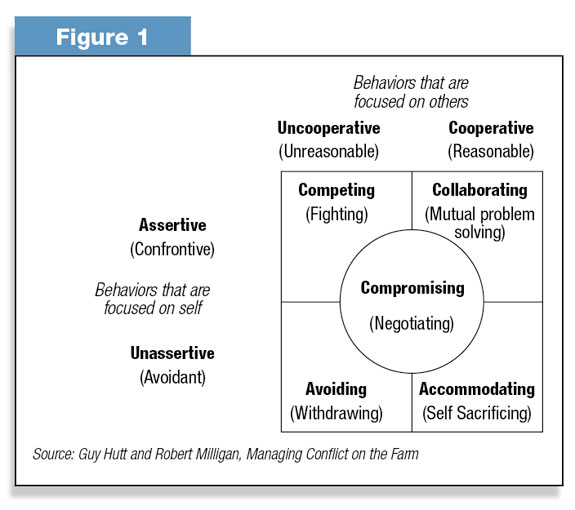Conflict is a daily reality for everyone. Some conflicts are relatively minor and easy to handle. However, others of greater magnitude require a strategy for successful resolution or else they will create constant tension and lasting enmity in the business. Knowing how to manage and resolve these conflicts is important for the overall success of your business. Conflict is not necessarily bad. Properly managed, moderate doses of conflict can be beneficial. Conflict is the root of change and allows people to learn and grow. It stimulates curiosity and imagination, and relieves monotony and boredom. After conflict, closer unity may be established.
However, conflict can be harmful to your business and can divert time, energy and money away from the goals of your business. In addition, prolonged conflict can be injurious to a person’s physical and mental health. Various methods for managing conflicts are discussed. A step-by- step procedure also is discussed for resolving business disputes.
Conflict management styles

A framework for learning various conflict management styles is presented in Figure 1 . No one style is superior. The most effective style depends on the situation. You should master all of the styles and know when to use each one.
In the figure, two basic variables are plotted against one another. One variable is assertiveness, or the extent to which an individual attempts to satisfy his or her own concerns. The other is cooperativeness, or the extent to which the individual attempts to satisfy the other person’s concerns. These two dimensions define five distinct styles for coping with conflict: competition, collaboration, avoidance, accommodation and compromise.
1. Competition
Competition reflects a desire to meet one’s own needs and concerns at the expense of others (win/ lose situation). The most assertive and least cooperative people use the competitive style (see figure). To achieve the desired outcome, the competitor uses whatever power is available and acceptable, e.g., rank, persuasion, expertise, economics or coercion. Competition (or any other style) is neither good nor bad, but only one of the many styles that may be appropriate and effective, depending on the situation.
2. Accommodation
Accommodation means placing the other party’s needs and concerns above one’s own (lose/win). It is characterized by cooperative and unassertive behavior (see figure). Accommodation is appropriate and effective if one party is not as concerned as the other. It is effective when preserving harmony and avoiding disruption are important. It builds good will and leads to cooperative relationships.
3. Avoidance
People using this style simply do not address the conflict and are indifferent to each other’s needs and concerns (lose/lose). It is characterized by uncooperative and unassertive behavior by both parties (see figure). Avoidance can be employed effectively as a short-term or interim strategy until more information is available or emotions cool down. It can be used as a permanent strategy if the probability of satisfying one’s needs and concerns is exceedingly low.
4. Collaboration
People using a collaborative style aim to satisfy the needs and concerns of both parties (win/win). It involves the maximum use of both cooperation and assertion (see figure). Collaboration requires more commitment than the other styles and takes more time and energy. With this style, the parties often are more committed to the resolution because an outcome that meets the needs of both parties is more likely to be supported.
5. Compromise
Compromise is midway between the previous four styles (see figure). It will lead to a partial fulfillment of the needs, concerns and goals of both parties. Compared to collaboration, few issues are confronted. Compromise is appropriate when the goals of the parties are moderately important and not worth the effort and time required for collaboration.
Managing conflicts
Individuals involved in a business may need assistance in resolving conflicts. So you may need to assume a leadership role in managing and resolving these conflicts. Below are six steps or techniques you can use for managing a business dispute.
1. Initiate dialogue
Call the parties together and establish the fact that you will be open, honest and attentive to everyone’s needs in what is likely to be a sensitive situation. Discuss only present problems and discuss them one at a time. Remember, everyone has a right to talk. It is important to understand every person’s position.
2. Involve all parties
Next, involve all parties in the communication process. Involvement begins by asking questions and encouraging others to answer. Listen as people respond to your questions.
3. Assimilate information
The third phase is to assimilate all this information. Everyone must consider all of the facts and feelings. Clarify every position expressed and its cause.
4. Reinforce agreements
The next step is to reinforce agreements. Reinforcing agreements is a powerful psychological tool. This process builds trust and understanding and makes negotiating easier. Always reinforce agreements before you negotiate disagreements.
5. Negotiate disagreements
This begins by reviewing and ranking the disagreements. When issues are ranked, seek adjustments from each adversary, with the most insignificant or easiest problem first. Remind them that you cannot negotiate disagreements until the facts and feelings are understood by everyone.
6. Solidify agreements
The last step is to solidify agreements and confirm solutions to the problem. Begin by reviewing the changes agreed to and ask if compromises are still acceptable. Review proposed actions carefully. Commitment to the adjustment can be confirmed through formal or informal contracts, a checklist or a handshake. PD
References omitted due to space but are available upon request by sending an email to editor@progressivedairy.com .
— Excerpts from Iowa State University Decision Maker, December 2009

-
Don Hofstrand
- Resource Center
- Iowa State University
- Email Don Hofstrand





